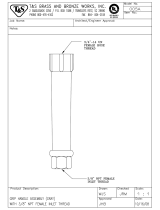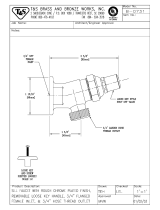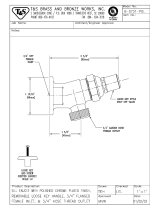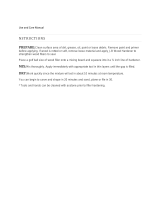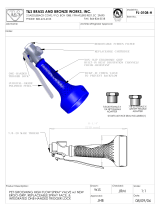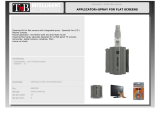Page is loading ...

77-2984 1/66
EN
GLOBAL ELECTRONIC MIX SOLUTIONS
PLURAL COMPONENT MIXING SYSTEM FOR ACID CATALYST
OPERATION MANUAL

2/66 77-2984
EN
Table of Contents
1: Introduction...………………………...……..4
1.1: Features……..……...……...…...4
1.2: System Part Numbering….....5
1.3: Technical Specifications….....5
2: Wall Mount Dimensions……................6
2.1: Floor Stand Dimensions.…....7
3: Installation Diagram for Non-Hazardous Locations:
3.1: Connecting Direct Power …..3.1
4: Component Overview………...…………..4
4.1: Control Enclosure Detail…....4.1
5: Air Connections………………………….....5
5.1: Control Enclosure Air Connections….
5.2: Fluid Panel Air Connections……...
6: Fluid Connections……………………...6
6.1: Fluid Panel Connections……...
7: User Interface Guide………………….7
7.1: Home Screen Buttons…..….7.1
7.2: Home Screen Information..7.2
7.3: Color Change Screen……….7.3
7.4: Usage Screen………………….7.4
7.5: Prime Screen…………………..7.5
7.6: Alarm Screen…………………..7.6
7.7: Alarm History…………………..7.7
7.8: Alarm Help Screen…………...7.8
7.9: Settings Screens.……………...7.9
7.9.1: Password Prompt……7.9.1
7.9.2: System Settings……..7.9.2
7.9.3: Color Setup………......7.9.3
7.9.4: Ratio Entry……………..7.9.4
7.9.5: Flush / Load Sequence..7.9.5
7.9.6: Calibration Resin+Hardener..
7.9.7: Calibration Resin Only…..7.9.7
7.9.8: Alarm Enables………..7.9.8
7.9.9: Dispense Pump Limits…..7.9.9
7.9.10: Time/Password Setup...7.9.10
7.9.11: FTP Server Configuration….
7.9.12: System Configuration…..7.9.12
7.10: Jobs Screen…....……..……...7.10
7.11: Batch Screen…………………..7.11
7.12: Language Selection………....7.12
8: Startup Guide………………………..…8
8.1: Startup Procedure…………..8.1
9: Daily Operations……….………9
9.1: Daily Start Up Procedure…9.1
9.2: Loading a Color………………9.2
9.3: Color Change Procedure….9.3
9.4: Flushing Setup ………………9.4
9.5: End of Day Flushing…...….9.5
9.6: System Depressurization…..9.6
10: Alarm Guide………….10
11: Flow Meter……………………………….11
11.1: Flow Meter Calibration…….11.1
12: B Pump Operation……………………..12
12.1: B Pump Troubleshooting Checklist..12.1
13: Power Outage Cleaning Procedure….13
13.1: Solenoid Connection Reference
14: Accessories……………...……….……..14
15: Glossary of Terms……………………..15

77-2984 3/66
EN
It is the of the to this to the of the
For see the
READ THE MANUAL
read and all safety, and
TRAINING
EQUIPMENT HAZARD
can cause the to or start
LOCK OUT / TAG-OUT
Failure to de-energize, disconnect, lock out and tag-out all power sources before
performing equipment maintenance could cause serious injury or death.
PRESSURE RELIEF PROCEDURE
Always follow the pressure relief procedure in the equipment instrucon manual.
AUTOMATIC EQUIPMENT
Automac equipment may start suddenly without warning.
KEEP EQUIPMENT GUARDS IN PLACE
KNOW WHERE AND HOW TO SHUT OFF THE EQUIPMENT IN CASE OF AN EMER-
GENCY
WEAR SAFETY GLASSES
Failure to wear safety glasses with side shields could result in serious eye injury or
INSPECT THE EQUIPMENT DAILY
Inspect the equipment for worn or broken parts on a daily basis. Do not operate the
NEVER MODIFY THE EQUIPMENT
Do not modify the equipment unless the manufacturer provides wrien
STATIC CHARGE
Fluid may develop a stac charge that must be dissipated through proper grounding
of the equipment, objects to be sprayed and all other electrically conducve objects
in the dispensing area. Improper grounding or sparks can cause a hazardous condi-
on and result in re, explosion or electric shock and other serious injury.
ELECTRIC SHOCK / GROUNDING
Improper equipment grounding, poor venlaon, open ame or sparks can cause hazard-
ous condions and result in re or explosion and serious injury.
PROJECTILE HAZARD
You may be injured by venng liquids or gases that are released under
PINCH POINT HAZARD
Moving parts can crush and cut. Pinch points are basically any areas where there are
NOISE HAZARD
You may be injured by loud noise. Hearing protecon may be required when using
PROP 65 WARNING
WARNING: This product contains chemicals known to the State of California
HIGH PRESSURE CONSIDERATION
High pressure can cause serious injury. Relieve all pressure before servicing. Spray
from the spray gun, hose leaks, or ruptured components can inject uid into your
WEAR RESPIRATOR
Toxic fumes can cause serious injury or death if inhaled. Wear a respirator as recom-
mended by the uid and solvent manufacturer’s Material Safety Data Sheet.
TOXIC FLUID & FUMES
Hazardous uid or toxic fumes can cause serious injury or death if splashed in the
eyes or on the skin, inhaled, injected or swallowed. LEARN and KNOW the specic
FIRE AND EXPLOSION HAZARD
Improper equipment grounding, poor venlaon, open ame or sparks can cause a
Read the following warnings before using this equipment
! WARNING
In this manual, the words WARNING, CAUTION and NOTE are used to emphasize important safety informaon as follows:
NOTE
or
in
! WARNING
! CAUTION
Plural Component Materials Hazard
Because of the vast number of chemicals that could be used and their varying chemi-
cal reacons, the buyer and user of this equipment must determine all facts relang
to the materials used, including any of the potenal hazards
Halogenated hydrocarbon solvents can cause an explosion when in contact with
aluminum components of a pressurized or closed uid system.
READ THE MANUAL
read and all safety, and
TRAINING
EQUIPMENT HAZARD
can cause the to or start
PRESSURE RELIEF PROCEDURE
Always follow the pressure relief procedure in the equipment instrucon manual.
KEEP EQUIPMENT GUARDS IN PLACE
KNOW WHERE AND HOW TO SHUT OFF THE EQUIPMENT IN CASE OF AN EMER-
GENCY
WEAR SAFETY GLASSES
Failure to wear safety glasses with side shields could result in serious eye injury or
PROJECTILE HAZARD
You may be injured by venng liquids or gases that are released under

4/66 77-2984
EN
1: Introduction
1.1: Features
The GEMS System has unique features that provide superior benefits:
Continuous Flow—The mix manifold is designed to optimize mix quality and minimize internal volume by
receiving Resin (Component A) and Hardener (Component B) continuously.
Accurate Dispensing—Control and positioning of the B metering pump is precise. An electronically
controlled stepper motor with integral linear actuator allow for dispense from 2cc to 200cc per minute, and
ratios from 10:1 to 100:1. Ratio tolerance down to 1% is possible.
Ease of Use—The touchscreen user interface is easy to learn and efficient to use. It provides control of the
system with few actions, along with real-time data and in-depth troubleshooting when alarms occur.
Easily Configurable— Use up to five different paint resins and up to two spray guns. Flush boxes,
atomizing air control, and other options and accessories can be added at any time.
Programmable Flushing— Set unique flushing options specific to material needs.
Mounting Options—The system can be mounted to a wall and plumbed into an existing workspace, or it
can be bolted to the floor with an available pedestal stand.
Alarm Warnings—The alarm system warns the user of system errors and suggests possible solutions. Help
screens provide troubleshooting information to remedy system alarms.
Modular Design—Sub-assemblies are easily and quickly removed for maintenance and repair.
The GEMS system is designed to accurately mix most two component (2K) liquid coatings. It will supply any
low or medium-pressure manual or automatic spray gun up to 1000 psi fluid pressure and can easily handle
very low flow rates or high ratio materials (greater than 20:1). The system uses real-time metering to
accurately dispense and mix the resin and hardener on-ratio regardless of varying flow rate as seen in real
world paint applications such as feathering or rapid triggering with manual guns.
The system is easily set up and operated with a 7” touch screen. Access to system parameters and usage
data is restricted via password protection. The Acid-Catalyst version of the machine allows the unit to be
used with 2K paints that utilize organic acid catalysts.
GEMS systems are configurable with many options
and accessories:
Up to 5 paint colors
Gun flush boxes
Pedestal Stand
Stack light
Atomizing air cut-off
2nd gun capability
See section 14 in this manual for information on
accessory equipment.

77-2984 5/66
EN
1.2: System Part Numbering
If the example number shown above was ordered the customer would receive the following:
Binks GEMS AC system for 1 color, one gun flush box, no in-booth capability, and 0-1000 psi range .
Gun Flush Boxes:
0 = none
1 = 1 Flush Box
1 = 2 Flush Boxes
In-booth uid panel:
0 = no in-booth capability
1 = In-booth color changer
and uid panel setup with
50’(15.2m) cables and tubing
bundle
Low / High Pressure:
0 = 250 psi max
1 = 1000 psi max
E2A-1101
Number of Colors:
1 = 1 Color
2 = 2 Color
3 = 3 Color
4 = 4 Color
5 = 5 Color
TECHNICAL SPECIFICATIONS
Max Working Air Pressure 105 psi 7.2 bar
Optimal Working Air Pressure 75-105 psi 5.2—7.2 bar
Max Inlet Fluid Pressure 1000 / 250 psi 69 / 17.2 bar
Max Dispense Pump Flow Rate 7 oz/min 200 cc/min
Min Dispense Pump Flow Rate 0.07 oz/min 2 cc/min
“A” Side Flowmeter Range 1.3-64 oz/min 40-1900 cc/min
Operating Temperature Range 41-122 Fahrenheit 5-50 Celsius
System Weight 130-150 lbs. 59-68 Kg
Viscosity Range of Fluid 20-3000 cPs
Mixing Ratio Range 10:1 – 100:1
Ratio Tolerance Range Up to +/- 1%
Wetted Parts 300 series stainless
steel, PTFE, perfluoro-
elastomer, UHMW poly-
ethylene
External Power Requirements
100-240 VAC, 50-60Hz.
1.4 Amp, 16 AWG power
Environmental Indoor use, pollution
degree (2)
1.3: Technical Specifications

6/66 77-2984
EN
2: Wall Mount Dimensions
Shown with standard wall mount and accessory stack light kit (240-3115)
Wall mounting requirements:
-Ensure wall is able to support weight of complete system, including air and fluid hoses
and other connected devices. (Minimum 200 lbs. [91 kg])
-Ensure clearance for electrical and fluid connections to unit, and door swing radius.
-Bolt frame sections to wall or panel using minimum 4 each of 3/8” lag screws or cap
screws with flat washers.

77-2984 7/66
EN
2.1: Floor Stand Dimensions
Shown with accessory floor stand kit (240-3160) and accessory stack light kit (240-3115)
Stand mounting requirements:
Bolt stand to floor per recommendations in 77-3092 Stand Assembly Instructions.

8/66 77-2984
EN
3: Installation Diagram for Non-Hazardous Locations
Wall or stand-mounted systems
3.1: Connecting Direct Power
Neutral
Line
Open
AC LOCK OUT SWITCH: Top right corner of control enclosure
If direct connection to power disconnect is
preferred to AC power cord, use AC Conduit
Kit (part#: 76453). Installation should only
be performed by a qualified electrician.
Connect power as follows:
1. Remove AC Inlet assembly. Install 76453
kit.
2. Use a compatible cord grip / strain relief.
3. Connect power cord to the appropriate
terminals as shown at left.
4. For the complete electrical schematic
please see the electrical diagram section
in the Maintenance and Repair
Manual 77-2983.

77-2984 9/66
EN
Before making electrical, air, and fluid connections to GEMS, be sure to understand and verify all
requirements for installation, including but not limited to: electrical codes, OSHA requirements, NFPA
requirements, and all applicable local codes and ordinances.
Read and understand all operating manuals for connected equipment. Do not supply GEMS with higher
fluid or air pressures than recommended in the technical specifications section of this manual.
WARNING
Control enclosure cannot be placed in a hazardous location. Do not use equipment not approved for
hazardous locations. Do not modify system equipment.
WARNING
WARNING
To maintain non-hazardous classification of this equipment, the dispense pump and fluid panel
components and assemblies must be monitored for leaks and serviced regularly to prevent leaks from
occurring. If a leak is discovered the system must be immediately shut down, de-energized, and repaired
to correct the problem.
WARNING
This equipment is only to be used in the manner specified. If not used in the specified manner the
protection provided by the equipment may be impaired.
WARNING
Do not replace the detachable mains supply power cord with inadequately rated cords.

10/66 77-2984
EN
4 : Component Overview
6
9
11
4
14
10
1
13
12
2
3
8
5
7
Optional equipment shown for illustration

77-2984 11/66
EN
Item Description Part Number
1 Universal AC– Inlet. Select the appropriate cable as needed (USA /
Canada cable Part # 76449).
240-3052
2 AC Lock Out Switch. The on/off lock out switch for system power.
Can be locked off for lockout / tagout.
A12411-00
3 Air Cutoff Valve that controls gun atomizing air. Standard with gun
flush boxes, but also available as add on kit.
Kit P/N:
240-3118
4 Catalyst Pump. Driven by a motor, the pump dispenses the calculat-
ed volume of hardener or catalyst to the mix manifold to provide the
correct ratio of mixed material.
240-3208
(Fluid End)
5 Hardener Tube Assembly. Tube assembly from output of catalyst
pump to mix manifold.
240-3242
6 Mix Manifold contains a valve to start and stop the flow of paint to
the gun, a built-in check valve for catalyst, and a central chamber to
pre-mix the coating components.
240-3240
7 Static mix assembly. Contains replaceable mix elements. 240-3231
8 Resin hose assembly. Component A hose connects flow meter to AE
valve.
240-3241
9 Gear flow meter with up to 1900cc / min measurement capability. A12712-01
10 Solvent Meter. Measure flushing solvent usage with accessory solvent
meter.
Accessory Kit:
240-3213
11 Color Stack. A series of color change valves (CCV’s) and manifold
blocks for up to 5 different coating resin colors and solvent valve.
240-3230
12 Touch Screen Display. 7” resistive touch interface includes USB and
Ethernet capability. See section 7 for operating instructions.
240-3172
13 Stack Light. Accessory stack lights for 360 degree visibility of in-use/
alarm indication.
Accessory Kit:
240-3115
14 Optional Floor Pedestal Stand Accessory Kit:
240-3160
NOTE
Accessory items not included in system part number; may be installed by distributors.

12/66 77-2984
EN
4.1: Control Enclosure Detail
Power supply rail - contains
24V DC power supply, fuses,
and terminal blocks.
Main board - contains all
input, output, and control
processing.
Solenoid stack - operates uid
panel and air cuto valves.
Pressure switches - used with
gun ush boxes to signal “gun in
the box” and allow safe ushing
Linear actuator - controlled by the
Main Board to move the B Pump.
An aached linear potenometer
indicates the pump’s posion at
any me.
USB ash drive - stores all Job
and Alarm history.
Air ow switches - used to indi-
cate triggering of a spray gun
to the system control.

77-2984 13/66
EN
5 : Air Connections
Air pressure for the control enclosure should range from 75-100 psi (5 to 7 bar) for proper actuation of the
system valves. Clean, dry (-40F [-40C] dew point), regulated compressed air is recommended for use with all
pneumatic components in this system. Air filters, coalescers, regulators, and dryers are not included with the
system. Consult your representative for details concerning air control equipment.
Air pressure for spray gun atomizing air should be greater than 10 psi (1.5 bar) for proper function of the air
flow switches.
Num-
ber
Hose
# Description
Tube
OD
Connecting
Thread
Connect-
ing Bulk-
A1 —- Main air inlet —- 1/4 npt female A1
A2 —- Main air exhaust —- 1/4 npt female A2
A3 —- Gun 1 Atomizing air inlet —- 1/4 nps male —-
A4 —- Gun 1 Atomizing air outlet —- 1/4 nps male —-
A5 —- Gun 2 Atomizing air inlet —- 1/4 nps male —-
A6 —- Gun 2 Atomizing air outlet —- 1/4 nps male —-
A7 —- Solenoid manifold air inlet 1/4” —- —-
A8 —- Solenoid manifold exhaust 1/4” —- —-
A9 ACO Gun 1 Atomizing air control 5/32” —- B16
A10 ACO Gun 2 Atomizing air control 5/32” —- B16
A11 GIB1 B15 Gun In Box 1 (GIB1) Air Signal 5/32” —-
A12 GIB2 B16 Gun In Box 2 (GIB2) Air Signal 5/32” —-
View of control enclosure interior
Bulkhead Numbering
5.1: Control Enclosure Air Connections

14/66 77-2984
EN
5.2: Fluid Panel Air Connections
Loca-
tion
Hose
#
Connect-
ing Bulk- Description Tube OD
Connecting
Thread
A14 B1 B01 Dispense pump top inlet signal 5/32” 1/8 npt
A15 B3 B03 Dispense pump bottom inlet signal 5/32” 1/8 npt
A16 B2 B02 Dispense pump top outlet signal 5/32” 1/8 npt
A17 B4 B04 Dispense pump bottom outlet signal 5/32” 1/8 npt
A19 A0 B06 Solvent flush signal 5/32” 1/8 npt
A20 AE B07 Resin Enable Valve signal 5/32” 1/8 npt
A21 A1 B08 Color 1 signal 5/32” 1/8 npt
A22 A2 B09 Color 2 signal 5/32” 1/8 npt
A23 A3 B10 Color 3 signal 5/32” 1/8 npt
A24 A4 B11 Color 4 signal 5/32” 1/8 npt
A25 A5 B12 Color 5 signal 5/32” 1/8 npt
A26 TRG2 B13 Gun Box—Trigger gun 2 signal 5/32” —-
A27 TRG1 B14 Gun Box— Trigger gun 1 signal 5/32” —-
View of fluid panel

77-2984 15/66
EN
5.2: Air Connection Descriptions
A1- Main air to the control enclosure; powers all solenoids for
unit operation. Make sure clean and dry 75-100psi air is sup-
plied to the unit . 1/4” NPT female connection.
A2 - Control Enclosure exhaust port. 1/4” NPT with muffler.
A3 - Atomizing air inlet to gun 1. 1/4” NPS male connection.
Requires clean, regulated air from 20 to 100 psi (1.5 to 7 bar)
as appropriate for paint atomization.
A4 - Atomizing air outlet (to gun 1). 1/4” NPS male connection.
Connect air hose to air inlet of spray gun 1.
A5 - Atomizing air inlet to gun 2. 1/4” NPS male connection.
Requires clean, regulated air from 20 to 100 psi (1.5 to 7 bar)
as appropriate for paint atomization.
A6 - Atomizing air outlet (to gun 2). 1/4 NPS male connection.
Connect air hose to air inlet of spray gun 2.
A7 - Solenoid Manifold air inlet. Must be energized with mini-
mum pressure of 75psi for proper operation. 1/4” OD tube.
A8 - Solenoid manifold exhaust port. All exhaust air should be
vented out of the control enclosure to prevent moisture contam-
ination of electrical components. 1/4” OD tube.
A9 & A10- Optional atomization air shut-off signal (ACO). Signal
comes from Solenoid ACO, or from Gun Box ACO if present.
Signal is split with y-connector if two guns are used without gun
flush boxes.
A11 - Gun In Box 1 signal (GIB1). Lets the system know that
the gun is locked in the flush box and is ready to flush or load.
A12 - Gun In Box 2 signal (GIB2) lets the system know that the
gun is locked in the flush box and is ready to flush or load.
A14 - Top inlet valve of dispense pump (B1). Sequencing of
pump controlled by the board, and solenoid valves trigger oper-
ation so that that the proper fluid pathways are opened and
closed. 1/4” NPT female.
A15 - Bottom inlet valve of dispense pump (B2). Air signal from
control opens the CCV. 1/4” NPT female.
A16 - Top outlet valve of dispense pump (B3). Air signal from
system opens the CCV. 1/4” NPT female.
A17 - Bottom outlet valve of dispense pump (B4). Air signal
from the system opens the CCV. 1/4” NPT female.
A19 - Solvent valve signal (A0). Controls the use of solvent for
flushing, color changes, and during air/solvent chops.
A20 - Resin Enable valve signal (AE). Controls the flow of resin
for normal spraying and when not in use such as in Alarm
states, and when performing a Hardener Prime.
A21 - Color 1 signal (A1). Controls the flow of resin color 1.
A22 - Color 2 signal (A2). Controls the flow of resin color 2.
A23 - Color 3 signal (A3). Controls the flow of resin color 3.
A24 - Color 4 signal (A4). Controls the flow of resin color 4.
A25 - Color 5 signal (A5). Controls the flow of resin color 5.
A26 - Gun 2 trigger signal (TRG2) . For use with gun flush box-
es, aids in the automatic flushing process.
A27 - Gun 1 trigger signal (TRG1). For use with gun flush box-
es, aids in the automatic flushing process.
Use this list for additional information regarding the GEMS air connections. If needed, refer to the previous pages for
detail regarding hose numbering, and the physical locations of each of these air connections. For information re-
garding fluid connections, see 6.1: Fluid Panel Connections.

16/66 77-2984
EN
6 : Fluid Connections
Material resins and hardeners may be supplied to the
Binks GEMS circulating systems or pumping systems.
Fluid must be delivered free from pressure spikes and
surges, and entrained air must be avoided. If feeding
directly from a pump, a fluid regulator is
recommended upstream from the color stack so that
pulsations are not measured through the flow meter.
Fluid supplied to the Binks GEMS must also be free of
contaminants and solid particles that may clog or jam
the flow meter gears or other downstream
components. Typical filtration for paint resins is 100
mesh or smaller. Contact your Binks representative
for information regarding fluid supply and
conditioning equipment.
For compression fittings with ferrules, tighten the
ferrule nut 1 to 1.5 turns past finger tight. Do not
over tighten, as exceeding 1.5 turns will likely cause
the ferrules to cut through the tubing.
For pipe threads (NPT) use PTFE tape or other pipe
thread sealant for stainless steel connections. If using
tape, wrap clockwise two to three times around the
threads. Ensure tape does not protrude beyond
threads. If using liquid sealant, apply sealant bead
completely around 2nd male thread.
Number Description Connection Type
F1 Solvent Inlet 1/4”NPT female
F2 Color 1 Inlet 1/4" NPT female
F3 Color 2 Inlet 1/4" NPT female
F4 Color 3 Inlet 1/4" NPT female
F5 Color 4 Inlet 1/4" NPT female
F6 Color 5 Inlet 1/4" NPT female
F8 Dispense Pump Inlet 1/4" NPT female
F9 Mix manifold outlet (end of static mixer) 1/4” NPS Male
F10 Solvent inlet (Accessory solvent meter) 1/4” NPS Male
NOTE
The inlet fluid pressure of the Dispense Pump should always be maintained 5 to 10% above
the outlet pressure. This ensures proper operation of the Dispense Pump.

77-2984 17/66
EN
6.1: Fluid Panel Fluid Connections
*Note: Oponal
Solvent Meter
Shown
F1 - Solvent inlet (color stack). The ush solvent inlet is
located at the top right side of the color stack. A 1/4”
NPT male threaded check valve is supplied in the inlet of
the color stack. Aach solvent supply line or solvent me-
ter hose to 1/4” NPT elbow.
F2-F6— The oponal number of colors (1-5). Port threads
are 1/4” NPT female with plugs supplied in the back.
F8 - Inlet to Dispense Pump. 1/4” NPT female inlet. Con-
nect hardener/catalyst supply directly or to Dispense
Pump Flow Sensor if equipped. If feeding directly from a
pump, a uid regulator between the pump and resin ow
meter / color stack is recommended.
F9 - Mix manifold outlet. Connected to stac mixer as-
sembly (240-3122). The end of the stac mixer will have a
3/8” NPS male connector. Connect the spray gun’s uid
hose to this ng.
F10 - Solvent Meter Kit inlet. Fing used is a 1/4” NPS for
solvent inlet line. Outlet of meter connects to F1.
The check valve at F1 is required for proper operation, do not remove!
CAUTION

18/66 77-2984
EN
6.2: Valve Numbering
These labels are related to the solenoids located inside the control enclosure. Note that resins are referred to
Component A material, and the valves are labeled accordingly with “A” for individual colors. Valves on the
dispense pump control the catalyst/hardener component B and are labeled B1-B4. See below for additional
detail.
A0: Solvent enable valve. Controls ushing sol-
vent.
A1: Component A color #1 enable valve. Acvates
when color is selected.
A2: Component A color #2 enable valve. Acvates
when color is selected.
A3: Component A color #3 enable valve. Acvates
when color is selected
A4: Component A color #4 enable valve. Acvates
when color is selected
A5: Component A color #5 enable valve. Acvates
when color is selected.
A7: Flushing air valve. Controls ushing air for col-
or loads and ush sequences.
AE: Component A Enable valve. Allows resin mate-
rial to be set to the mix manifold for stac mixing.
B1: Component B upper inlet valve.
B2: Component B upper outlet valve. Material
travels through the body of this valve and out of the
pump.
B3: Component B lower inlet valve. Material en-
ters the pump through the body of this valve.
B4: Component B lower outlet valve.
Component A
Component B

77-2984 19/66
EN

20/66 77-2984
EN
7 : User Interface Guide
The touch screen display is used to control GEMS. The following pages identify the various screens and their
associated controls. Read through this guide to understand how to use the user interface and operate GEMS
on a daily basis. Press the corresponding buttons for an action, as described in the following pages.
7.1 : Home Screen Buttons
1
2
3
4
6
5
7
1. Home: This button can be pushed at any
time to return the display to the Home Screen.
2. Color: Used to perform color changes and
programmed flush sequences. Advances to the
Color Change screen. Always visible.
3. Mute: Silence a sounding alarm. This
button will NOT reset the alarm, it will only
silence it until the alarm has been reset.
4. Alarms: Advances to the alarms screen to
reset alarms or view alarm history and
troubleshooting.
5. Usage: Advances to the usage and jobs
screens for paint usage totals and job
functions.
6. Prime: Advances to the Prime screen
for loading paint colors, solvent, and
hardener into the system.
7. Settings: Advances to the settings screens
(password protected) to change system
settings.
NOTE
If an alarm has not been reset, a flashing yellow background will display on the Home Screen. If so,
the machine will not spray, and the Reset button ( ) should be used. See 8.6: Alarm Screen.
/








